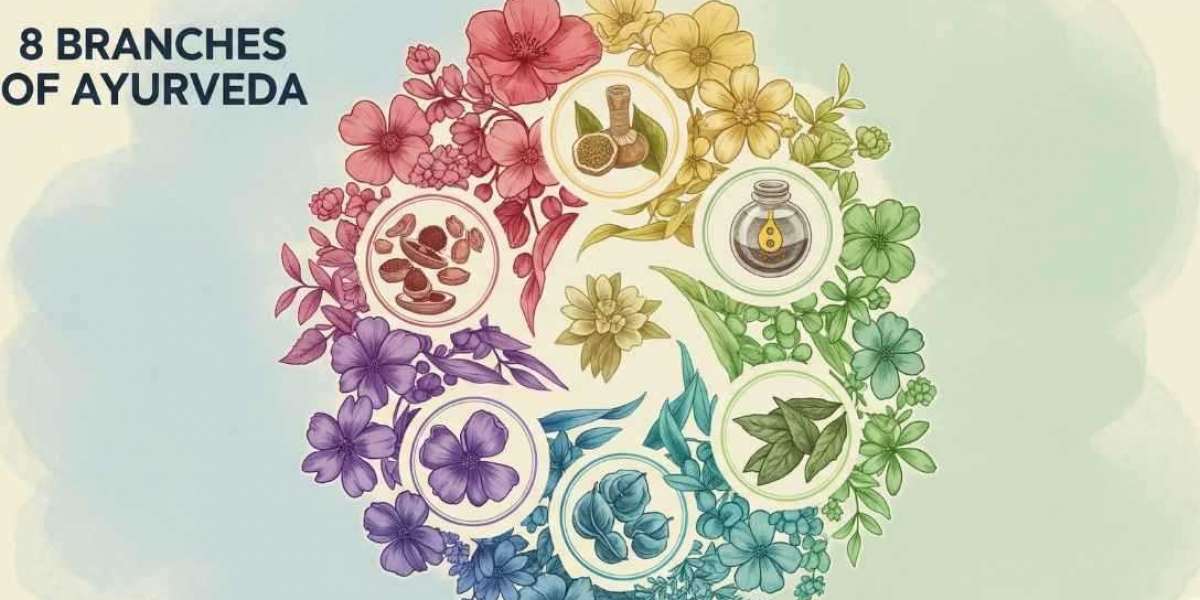Introduction to 8 Branches of Ayurveda
Ayurveda, one of the world’s oldest holistic healing systems, originated over 5,000 years ago in ancient India. Rooted in the Sanskrit words Ayur (life) and Veda (knowledge), Ayurveda means “the science of life.” Its core philosophy emphasizes balance between the mind, body, and spirit to promote overall well-being. Ayurveda comprises various disciplines that address all aspects of health. These disciplines are collectively known as the 8 branches of Ayurveda, or Ashtanga Ayurveda—a cornerstone of traditional Indian medicine.
The Shloka – 8 Branches of Ayurveda Shloka
In classical Ayurvedic texts, the eight branches are described in the following Sanskrit shloka:
“Kāyabala graha ūrdhvāṅga śalyadamṣṭrā jara vr̥ṣāḥ || Aṣṭāvaṅgāni tasyāhuḥ cikitsāyāṃ manīṣibhiḥ”
This translates to:
“Kāyachikitsa, Bālāchikitsa, Grahachikitsa, Urdhwanga, Shalyatantra, Damstrachikitsa, Jara, and Vrishatantra — these are the eight branches of Ayurveda as defined by the wise.”
The 8 Branches of Ayurveda in Sanskrit (Aṣṭāṅga Āyurveda)
| Sanskrit Name | English Meaning |
| Kāyachikitsā | Internal Medicine |
| Bālacikitsā | Pediatrics |
| Grahacikitsā | Psychiatry / Demonology |
| Ūrdhvāṅgacikitsā | ENT Ophthalmology |
| Śalyacikitsā | Surgery |
| Damṣṭracikitsā | Toxicology |
| Jāracikitsā | Geriatrics |
| Vṛṣacikitsā | Reproductive Medicine / Aphrodisiacs |
These form the foundational pillars of Ayurvedic practice.
Detailed Explanation About 8 Branches of Ayurveda
1. Kāyachikitsā (General Medicine)
This branch focuses on diagnosing and treating internal diseases. It includes therapies for digestive disorders, respiratory diseases, fevers, diabetes, and metabolic imbalances. It is akin to modern-day internal medicine.
2. Bālacikitsā (Kaumārbhritya – Pediatrics)
Dedicated to children’s health, this branch addresses neonatal care, breastfeeding techniques, immunity boosting, and child-specific ailments.
3. Grahacikitsā (Bhūtavidyā – Psychiatry)
Originally believed to treat mental illness caused by spiritual or demonic possession (Grahadosha), it now addresses mental disorders like anxiety, insomnia, depression, and other psychological ailments through herbal remedies and mantras.
4. Ūrdhvāṅgacikitsā (Śālākya Tantra – ENT Ophthalmology)
This branch specializes in diseases related to the head and sense organs — including eyes, ears, nose, throat, and mouth. Treatments include medicated oils, eye washes, and nasal therapies.
Urdhwanga branch of Ayurveda resembles modern-day Otolaryngology (ENT) and Ophthalmology.
5. Śalyacikitsā (Surgery)
Surgery was well-advanced in ancient India. This branch deals with fractures, wounds, removal of foreign objects, and surgical procedures described by Sushruta, the father of surgery.
6. Damṣṭracikitsā (Agadatantra – Toxicology)
This branch deals with toxins from food, animals (like snake bites), and environment. It also teaches antidote preparation and poison prevention.
7. Jāracikitsā (Rasāyana – Geriatrics and Rejuvenation)
Focuses on longevity, vitality, and aging. Rasayanas (rejuvenative therapies) are used to maintain youthfulness, improve memory, and enhance immunity.
8. Vṛṣacikitsā (Vājīkaraṇa – Aphrodisiacs and Fertility)
This branch enhances reproductive health, improves vitality, sexual performance, and treats infertility. It focuses on diet, herbal aphrodisiacs, and lifestyle management.








